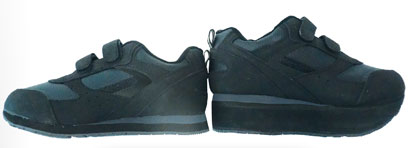
Athletic shoes with a 1″ lift on the right shoe. Proper lifts cover the entire sole of the shoe, not just the heel.
Often, a leg length discrepancy (LLD) of 2 cm or less is not a functional problem. But, when this difference becomes uncomfortable or causes pain, surgeons often recommend a shoe lift as an alternative to a surgical approach.
Shoe lifts can help equalize leg lengths, and they are the most common nonsurgical treatment for a leg length discrepancy. In many cases, the lift can bring the discrepancy down to a comfortable level. Use of a lift can often improve a patient’s ability to walk or run, and it can alleviate back pain associated with a smaller leg length discrepancy.
 While there are no medical risks associated with a shoe lift, it can be an expensive treatment option. Every pair of shoes worn must have the lift. If the lift is 1 cm (1/2 in.) or less, it can be placed inside the shoe. This type of lift can be switched from one shoe to another and is not visible to anyone else. For lifts that are greater than 1 cm in size, they are added underneath the shoe. These lifts are permanently attached to a particular shoe. Sometimes custom-made shoes are required.
While there are no medical risks associated with a shoe lift, it can be an expensive treatment option. Every pair of shoes worn must have the lift. If the lift is 1 cm (1/2 in.) or less, it can be placed inside the shoe. This type of lift can be switched from one shoe to another and is not visible to anyone else. For lifts that are greater than 1 cm in size, they are added underneath the shoe. These lifts are permanently attached to a particular shoe. Sometimes custom-made shoes are required.
Lifts can be used indefinitely as a means of managing a leg length discrepancy. Some patients, however, find it to be bothersome to continually have to worry about having a shoe lift with their shoes. The shoe lift treatment method also does not correct the discrepancy if you are not wearing shoes.
For a leg length discrepancy of more than 2 cm, the shoe lift is not an ideal option. It limits the type of shoes you can wear, looks unsightly, and often causes instability. Ankle sprains and broken ankles are common with lifts.
Sometimes, a foot-in-foot prosthesis can be used as a temporary measure for those with significant leg length discrepancies. But the prosthesis is bulky, and it can cause balance issues.
